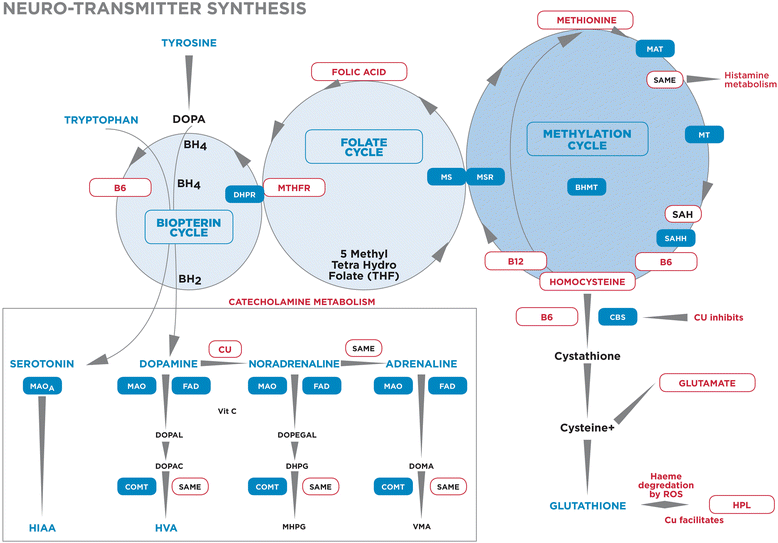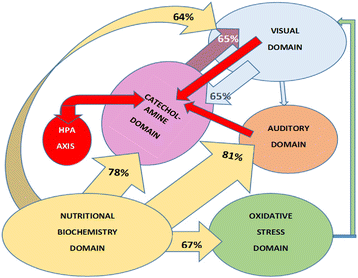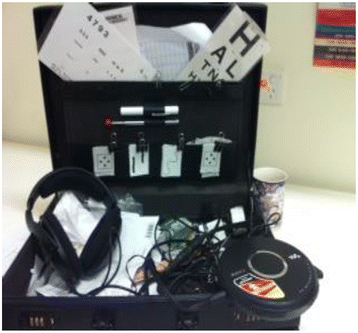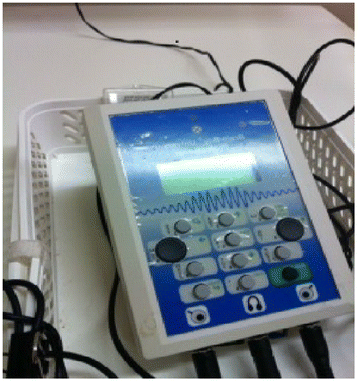Biomarkers of a five-domain translational substrate for schizophrenia and schizoaffective psychosis
- PMID: 25729574
- PMCID: PMC4342893
- DOI: 10.1186/s40364-015-0028-1
Biomarkers of a five-domain translational substrate for schizophrenia and schizoaffective psychosis
Abstract
Background: The Mental Health Biomarker Project (2010-2014) selected commercial biochemistry markers related to monoamine synthesis and metabolism and measures of visual and auditory processing performance. Within a case-control discovery design with exclusion criteria designed to produce a highly characterised sample, results from 67 independently DSM IV-R-diagnosed cases of schizophrenia and schizoaffective disorder were compared with those from 67 control participants selected from a local hospital, clinic and community catchment area. Participants underwent protocol-based diagnostic-checking, functional-rating, biological sample-collection for thirty candidate markers and sensory-processing assessment.
Results: Fifteen biomarkers were identified on ROC analysis. Using these biomarkers, odds ratios, adjusted for a case-control design, indicated that schizophrenia and schizoaffective disorder were highly associated with dichotic listening disorder, delayed visual processing, low visual span, delayed auditory speed of processing, low reverse digit span as a measure of auditory working memory and elevated levels of catecholamines. Other nutritional and biochemical biomarkers were identified as elevated hydroxyl pyrroline-2-one as a marker of oxidative stress, vitamin D, B6 and folate deficits with elevation of serum B12 and free serum copper to zinc ratio. When individual biomarkers were ranked by odds ratio and correlated with clinical severity, five functional domains of visual processing, auditory processing, oxidative stress, catecholamines and nutritional-biochemical variables were formed. When the strengths of their inter-domain relationships were predicted by Lowess (non-parametric) regression, predominant bidirectional relationships were found between visual processing and catecholamine domains. At a cellular level, the nutritional-biochemical domain exerted a pervasive influence on the auditory domain as well as on all other domains.
Conclusions: The findings of this biomarker research point towards a much-required advance in Psychiatry: quantification of some theoretically-understandable, translationally-informative, treatment-relevant underpinnings of serious mental illness. This evidence reveals schizophrenia and schizoaffective disorder in a somewhat different manner, as a conglomerate of several disorders many of which are not currently being assessed-for or treated in clinical settings. Currently available remediation techniques for these underlying conditions have potential to reduce treatment-resistance, relapse-prevention, cost burden and social stigma in these conditions. If replicated and validated in prospective trials, such findings will improve progress-monitoring and treatment-response for schizophrenia and schizoaffective disorder.
Keywords: Biomarkers; Mental illness; Noradrenaline; Psychosis; Schizophrenia; Sensory processing; Translational.
Figures





Similar articles
-
Biomarker Case-Detection and Prediction with Potential for Functional Psychosis Screening: Development and Validation of a Model Related to Biochemistry, Sensory Neural Timing and End Organ Performance.Front Psychiatry. 2016 Apr 14;7:48. doi: 10.3389/fpsyt.2016.00048. eCollection 2016. Front Psychiatry. 2016. PMID: 27148083 Free PMC article.
-
Fundamental Role of Methylenetetrahydrofolate Reductase 677 C → T Genotype and Flavin Compounds in Biochemical Phenotypes for Schizophrenia and Schizoaffective Psychosis.Front Psychiatry. 2016 Nov 9;7:172. doi: 10.3389/fpsyt.2016.00172. eCollection 2016. Front Psychiatry. 2016. PMID: 27881965 Free PMC article.
-
Cognitive and psychomotor effects of risperidone in schizophrenia and schizoaffective disorder.Clin Ther. 2008 Sep;30(9):1565-89. doi: 10.1016/j.clinthera.2008.09.014. Clin Ther. 2008. PMID: 18840365 Review.
-
Molecular Mechanisms Provide a Landscape for Biomarker Selection for Schizophrenia and Schizoaffective Psychosis.Int J Mol Sci. 2023 Oct 18;24(20):15296. doi: 10.3390/ijms242015296. Int J Mol Sci. 2023. PMID: 37894974 Free PMC article. Review.
-
[Interest of a new instrument to assess cognition in schizophrenia: The Brief Assessment of Cognition in Schizophrenia (BACS)].Encephale. 2008 Dec;34(6):557-62. doi: 10.1016/j.encep.2007.12.005. Epub 2008 Jul 9. Encephale. 2008. PMID: 19081451 French.
Cited by
-
Comparing Copper Serum Level and Cognitive Functioning in Patients With Schizophrenia and Healthy Controls.Basic Clin Neurosci. 2020 Sep-Oct;11(5):649-657. doi: 10.32598/bcn.9.10.11.5.2116.1. Epub 2020 Sep 1. Basic Clin Neurosci. 2020. PMID: 33643558 Free PMC article.
-
Biomarker Case-Detection and Prediction with Potential for Functional Psychosis Screening: Development and Validation of a Model Related to Biochemistry, Sensory Neural Timing and End Organ Performance.Front Psychiatry. 2016 Apr 14;7:48. doi: 10.3389/fpsyt.2016.00048. eCollection 2016. Front Psychiatry. 2016. PMID: 27148083 Free PMC article.
-
Sixty years of conjecture over a urinary biomarker: a step closer to understanding the proposed link between anxiety and urinary pyrroles.Lab Med. 2024 May 2;55(3):334-340. doi: 10.1093/labmed/lmad086. Lab Med. 2024. PMID: 37699019 Free PMC article.
-
Fundamental Role of Methylenetetrahydrofolate Reductase 677 C → T Genotype and Flavin Compounds in Biochemical Phenotypes for Schizophrenia and Schizoaffective Psychosis.Front Psychiatry. 2016 Nov 9;7:172. doi: 10.3389/fpsyt.2016.00172. eCollection 2016. Front Psychiatry. 2016. PMID: 27881965 Free PMC article.
-
Biomarkers in the Diagnosis and Prediction of Medication Response in Depression and the Role of Nutraceuticals.Int J Mol Sci. 2024 Jul 22;25(14):7992. doi: 10.3390/ijms25147992. Int J Mol Sci. 2024. PMID: 39063234 Free PMC article. Review.
References
-
- Domenici E, Muglia P. The search for peripheral markers in psychiatry by genomic and proteomic approaches. Expr Open Med Deign. 2007;1:235–51. - PubMed
LinkOut - more resources
Full Text Sources
Other Literature Sources

